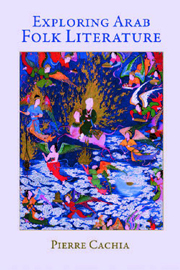Book contents
- Frontmatter
- Contents
- Acknowledgements
- Dedication
- Foreword by Professor Clive Holes
- Introduction
- The Transcription of Both Classical and Colloquial Arabic
- Part 1 Fact Finding
- 1 Arabic Literatures, ‘Elite’ and ‘Folk’ – Junctions and Disjunctions Quaderni di Studi Arabi, Nuova serie, 3 (2008)
- 2 The Egyptian Mawwāl: Its Ancestry, its Development, and its Present Forms Journal of Arabic Literature, 8 (1977)
- 3 The Nahḍa‘s First Stirrings of Interest in Alf Layla (previously unpublished).
- 4 The Career of Muṣṭafā > Ibrāhīm < Ajāj: A Giant of Egyptian Popular Literature Across Cultures, ed. Daniel Massa (Valletta, Malta, 1977)
- Part 2 Single or Related Items
- Part 3 Cultural and Social Implications
2 - The Egyptian Mawwāl: Its Ancestry, its Development, and its Present Forms Journal of Arabic Literature, 8 (1977)
from Part 1 - Fact Finding
Published online by Cambridge University Press: 05 February 2015
- Frontmatter
- Contents
- Acknowledgements
- Dedication
- Foreword by Professor Clive Holes
- Introduction
- The Transcription of Both Classical and Colloquial Arabic
- Part 1 Fact Finding
- 1 Arabic Literatures, ‘Elite’ and ‘Folk’ – Junctions and Disjunctions Quaderni di Studi Arabi, Nuova serie, 3 (2008)
- 2 The Egyptian Mawwāl: Its Ancestry, its Development, and its Present Forms Journal of Arabic Literature, 8 (1977)
- 3 The Nahḍa‘s First Stirrings of Interest in Alf Layla (previously unpublished).
- 4 The Career of Muṣṭafā > Ibrāhīm Across Cultures, ed. Daniel Massa (Valletta, Malta, 1977)
- Part 2 Single or Related Items
- Part 3 Cultural and Social Implications
Summary
One of many tantalising passages in al-Bayān wa t-Tabyīn comes in the context of the discussion of the superior eloquence of the Arabs, and proclaims the need to examine ‘how the Arabs came to tailor measured tunes to measured verses, combining measured with measured, whereas non-Arabs distort words – now contracting, now stretching them – in order to fit them into the measure of the tune, so that they combine the measured with the unmeasured’. Alas, the ebullient but undisciplined author never gets round to elaborating or illustrating his statement, and one is left with little more than an indication – scarcely surprising in an age of tumultuous racial and cultural contacts – that a multiplicity of artistic traditions was forcing itself on the attention of the intellectuals. Any resulting cross-fertilisation was presumably resisted by Arab and Arabised intellectuals of al-Jāḥiẓ's temper. It may nevertheless have played a part in the multi-rhyme experiments ascribed to Baššar b. Burd, Abū Nuwās and other poets of renown; it may account for the appearance in Umayyad times of the mutaqārib metre, soon integrated into ‘classical’ prosody; it may even have played a part in the emergence of the xazal genre in poetry. The role of Persians in the development of Arab singing has long been recognised. To what extent the popular literature of Arabic-speaking peoples was an amalgam of different lores and traditions can only be conjectured.
- Type
- Chapter
- Information
- Exploring Arab Folk Literature , pp. 19 - 41Publisher: Edinburgh University PressPrint publication year: 2011



